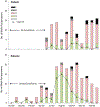Reassessment of high prevalence human adenovirus detections among residents of two refugee centers in Kenya under surveillance for acute respiratory infections
- PMID: 30242854
- PMCID: PMC8215849
- DOI: 10.1002/jmv.25320
Reassessment of high prevalence human adenovirus detections among residents of two refugee centers in Kenya under surveillance for acute respiratory infections
Abstract
Human adenoviruses (HAdVs) were previously detected at high prevalence by real-time reverse transcription-polymerase chain reaction (rRT-PCR) in the upper respiratory tract of residents of two Kenyan refugee camps under surveillance for acute respiratory infection (ARI) between October 2006 and April 2008. We sought to confirm this finding and characterize the HAdVs detected. Of 2148 respiratory specimens originally tested, 511 (23.8%) screened positive for HAdV and 510 were available for retesting. Of these, 421 (82.4%) were confirmed positive by repeat rRT-PCR or PCR and sequencing. Other respiratory viruses were codetected in 55.8% of confirmed HAdV-positive specimens. Species B and C viruses predominated at 82.8%, and HAdV-C1, -C2, and -B3 were the most commonly identified types. Species A, D, and F HAdVs, which are rarely associated with ARI, comprised the remainder. Viral loads were highest among species B HAdVs, particularly HAdV-B3. Species C showed the widest range of viral loads, and species A, D, and F were most often present at low loads and more often with codetections. These findings suggest that many HAdV detections were incidental and not a primary cause of ARI among camp patients. Species/type, codetections, and viral load determinations may permit more accurate HAdV disease burden estimates in these populations.
Keywords: Kenya; adenovirus; real-time reverse transcription-polymerase chain reaction (rRT-PCR); respiratory infections.
© 2018 Wiley Periodicals, Inc.
Conflict of interest statement
CONFLICTS OF INTEREST
The authors declare that they have no conflicts of interest.
Figures



Similar articles
-
Human adenovirus among hospitalized children with respiratory tract infections in Beijing, China, 2017-2018.Virol J. 2019 Jun 13;16(1):78. doi: 10.1186/s12985-019-1185-x. Virol J. 2019. PMID: 31196108 Free PMC article.
-
Molecular typing of adenoviruses in pediatric respiratory infections in Buenos Aires, Argentina (1999-2010).J Clin Virol. 2012 Feb;53(2):145-50. doi: 10.1016/j.jcv.2011.11.001. Epub 2011 Dec 3. J Clin Virol. 2012. PMID: 22138300
-
Detection of enteric- and non-enteric adenoviruses in gastroenteritis patients, Bangladesh, 2012-2015.J Med Virol. 2018 Apr;90(4):677-684. doi: 10.1002/jmv.25008. Epub 2018 Jan 11. J Med Virol. 2018. PMID: 29244212
-
High-Frequency Recombination of Human Adenovirus in Children with Acute Respiratory Tract Infections in Beijing, China.Viruses. 2024 May 23;16(6):828. doi: 10.3390/v16060828. Viruses. 2024. PMID: 38932121 Free PMC article.
-
Epidemiology of human adenovirus associated with respiratory infection in southern Brazil.Rev Med Virol. 2021 Jul;31(4):e2189. doi: 10.1002/rmv.2189. Epub 2020 Nov 6. Rev Med Virol. 2021. PMID: 33156553 Review.
Cited by
-
RSV Infection in Refugees and Asylum Seekers: A Systematic Review and Meta-Analysis.Epidemiologia (Basel). 2024 May 27;5(2):221-249. doi: 10.3390/epidemiologia5020016. Epidemiologia (Basel). 2024. PMID: 38920751 Free PMC article. Review.
-
THE EXPOSOME IN HUMAN EVOLUTION: FROM DUST TO DIESEL.Q Rev Biol. 2019 Dec;94(4):333-394. doi: 10.1086/706768. Q Rev Biol. 2019. PMID: 32269391 Free PMC article.
-
Research progress on human adenovirus sepsis.Front Pediatr. 2025 May 19;13:1552958. doi: 10.3389/fped.2025.1552958. eCollection 2025. Front Pediatr. 2025. PMID: 40458450 Free PMC article. Review.
-
Acute Adenoviral Gastroenteritis Complicated by Interstitial Edematous Pancreatitis in an Adult Patient: A Rare Clinical Case With a Multidisciplinary Approach.Cureus. 2025 Jul 5;17(7):e87328. doi: 10.7759/cureus.87328. eCollection 2025 Jul. Cureus. 2025. PMID: 40761965 Free PMC article.
-
Spatial modeling of mortality from acute lower respiratory infections in children under 5 years of age in 2000-2017: a global study.Clin Exp Pediatr. 2021 Dec;64(12):632-641. doi: 10.3345/cep.2020.01438. Epub 2021 Mar 19. Clin Exp Pediatr. 2021. PMID: 33752281 Free PMC article.
References
-
- Williams BG, Gouws E, Boschi-Pinto C, Bryce J, Dye C. Estimates of world-wide distribution of child deaths from acute respiratory infections. Lancet Infect Dis. 2002;2:25–32. - PubMed
-
- Hayden FG. Respiratory viral threats. Curr Opin Infect Dis. 2006;19:169–178. - PubMed
-
- Fox JP, Hall CE, Cooney MK. The Seattle Virus Watch. VII. Observations of adenovirus infections. Am J Epidemiol. 1977;105:362–386. - PubMed
-
- Edwards KM, Thompson J, Paolini J, Wright PF. Adenovirus infections in young children. Pediatrics. 1985;76:420–424. - PubMed
-
- Ruuskanen O, Metcalf JP, Waris M, Akusjarvi G. Adenoviruses. In: Richman DD, Whitley RJ, Hayen FG, eds. Clinical Virology, Fourth Edition. Washington, DC: ASM Press; 2017:pp. 575–598.
Publication types
MeSH terms
Grants and funding
LinkOut - more resources
Full Text Sources
Other Literature Sources
Miscellaneous

